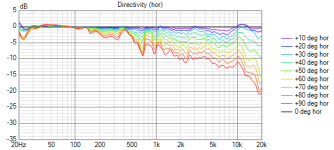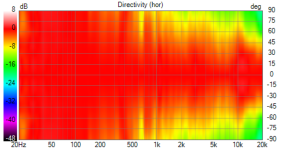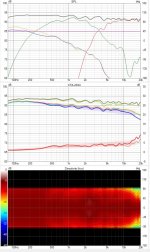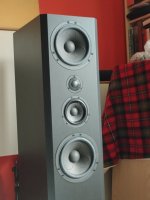This is the jig concept I have come up with for the production cut. I think this will be much improved over the saw setup in post #216

I will make a box-shaped jig to ride along the fence. It will have a large face plate, and the workpiece will be clamped to the faceplate.
I will make a box-shaped jig to ride along the fence. It will have a large face plate, and the workpiece will be clamped to the faceplate.
Good idea Jim ! Gonna remember this one for next time I have that type bastard cut to make.This is the jig concept I have come up with for the production cut. I think this will be much improved over the saw setup in post #216
Perhaps I've missed this, but is there a decision on the tweeter, or some candidates on the list? I'm just curious...
The short list is Bliesma T25A or T25B. After I have polar response data from the M74A in my prototype baffle, I will be able to do some simulation to see if the T25A/B tweeters will work well.
When I simulate the M74A as an ideal disk, it seems that it works better with more directional tweeter, such as the Satori TW29TX or TW29BN-B. The resulting directivity of the system is more even from 1k - 6k. But I do not trust the ideal-disk simulation to have this level of accuracy.
Honestly, almost any of the 1" dome tweeters have more directivity than the Bliesma T25A/B.
j.
When I simulate the M74A as an ideal disk, it seems that it works better with more directional tweeter, such as the Satori TW29TX or TW29BN-B. The resulting directivity of the system is more even from 1k - 6k. But I do not trust the ideal-disk simulation to have this level of accuracy.
Honestly, almost any of the 1" dome tweeters have more directivity than the Bliesma T25A/B.
j.
In the most cases 3or4" mid and 1" tweeter I would recommend no wg for tweeter, or very small and shallow, like 5mm. The first reason, it has the benefit to keep acoustic centers aligned. The second, this arrangement leads to gradually rising DI. I like this better. Using ~3inch wg would lead to constant DI in the treble range, the plateau from ~3kHz up. No wg, ACs aligned, LR2 will be very likely possible, allowing gradually rising DI. That was what I did for 12MU + ScanSpeak 9800, and before that for other projects as well.
I think it depends on the designer's goal. Or speaker concept, if I understand @kimmosto clearly.
It seems to me that a more gradual directivity change is better than an abrupt one.
But then the question is how directive you want your speaker to be, from very low directivity (closer to omni polar), low directivity speaker, medium directivity or high directivity speaker (closer to laser-like). And whether you want this in horizontal and/over vertical planes.
If we take this directivity concept... and comparing it to the typical 5.25" to 7" two way, with or without a waveguide...

if we push it further with smaller drivers, small baffler, then what we have would be similar to Bose L1 speaker, which released some 20 years ago:

As we hobbyists now have a better understanding of directivity through simulators like VituixCAD2 or AKABAK, we can start to understand how these commercials designs work.
As a real life example, a friend of mine bought a Bose L1 speaker for his living room, relying on the (reasonably) good reputation have in the PA space.
Unfortunately it was far too reverberant in his living for music playback. But his wife was a karaoke tragic. And it doesn't sound unlike those small karaoke bars you can frequent in the cities- lots of reverb. Like singing in the shower- you sound so much better (to yourself)
When I wanted to listen to his system, I put on some of audiophile style tracks eg. Rebecca Pidgeon, Alison Krause, Jennifer Warnes - it sounded far too reverberant...
I'm looking forward to see what Jim does with this design, and of course how it compares to his previous high performance speaker
But whether he prefers this speaker to his speaker may have a lot to do with him room acoustics and musical material preference... we shouldn't judge, he should be the judge...
It seems to me that a more gradual directivity change is better than an abrupt one.
But then the question is how directive you want your speaker to be, from very low directivity (closer to omni polar), low directivity speaker, medium directivity or high directivity speaker (closer to laser-like). And whether you want this in horizontal and/over vertical planes.
If we take this directivity concept... and comparing it to the typical 5.25" to 7" two way, with or without a waveguide...
if we push it further with smaller drivers, small baffler, then what we have would be similar to Bose L1 speaker, which released some 20 years ago:
As we hobbyists now have a better understanding of directivity through simulators like VituixCAD2 or AKABAK, we can start to understand how these commercials designs work.
As a real life example, a friend of mine bought a Bose L1 speaker for his living room, relying on the (reasonably) good reputation have in the PA space.
Unfortunately it was far too reverberant in his living for music playback. But his wife was a karaoke tragic. And it doesn't sound unlike those small karaoke bars you can frequent in the cities- lots of reverb. Like singing in the shower- you sound so much better (to yourself)
When I wanted to listen to his system, I put on some of audiophile style tracks eg. Rebecca Pidgeon, Alison Krause, Jennifer Warnes - it sounded far too reverberant...
I'm looking forward to see what Jim does with this design, and of course how it compares to his previous high performance speaker
But whether he prefers this speaker to his speaker may have a lot to do with him room acoustics and musical material preference... we shouldn't judge, he should be the judge...
Last edited:
The point I wanted to make: wg is not the only mean, or in other words, it is not needed to achieve gradual DI, given 3"+1" drivers.
This might be an Oz expression... what does "karaoke tragic" mean... ?But his wife was a karaoke tragic.
Regarding the target directivity for this system: I made the decision from the start to use the M74A driver, so whatever inherent directivity this driver has over its range, that is the target. I need a woofer with the appropriate directivity to match up well at 500 Hz. I need a tweeter with the appropriate directivity to match up well at 3.5 kHz. It is for this reason that I am prototyping and data-collecting the midrange driver, because the directivity of the midrange is a defining design constraint.
In the most cases 3or4" mid and 1" tweeter I would recommend no wg for tweeter, or very small and shallow, like 5mm. The first reason, it has the benefit to keep acoustic centers aligned. The second, this arrangement leads to gradually rising DI. I like this better. Using ~3inch wg would lead to constant DI in the treble range, the plateau from ~3kHz up. No wg, ACs aligned, LR2 will be very likely possible, allowing gradually rising DI. That was what I did for 12MU + ScanSpeak 9800, and before that for other projects as well.
Very useful advices....when you have 3 or 4 inch cone mid, acoustical centre is approx 15-20 mm behind, then you need WG or small step to move tweet backward to make simple LR2...
Where is AC in these big bubbled domes....Is it in line where dome is atached to surround and coil former or somewhere more in front?
Sasha KC83: ... or tilt the baffle. I actually like the combination of mild baffle tilt ~5deg and shallower WG.
Last edited:
Perhaps this is the reason why Joachim Gerhard has selected the Scan Speak tweeter and not the Bliesma one to partner with the M74. The Satori tweeters are somehow a bit large and resulting too directional that causes a "dark" sound tendency, so the Scan Speak with 1" coil might be a good compromise.The short list is Bliesma T25A or T25B. After I have polar response data from the M74A in my prototype baffle, I will be able to do some simulation to see if the T25A/B tweeters will work well.
When I simulate the M74A as an ideal disk, it seems that it works better with more directional tweeter, such as the Satori TW29TX or TW29BN-B. The resulting directivity of the system is more even from 1k - 6k. But I do not trust the ideal-disk simulation to have this level of accuracy.
Honestly, almost any of the 1" dome tweeters have more directivity than the Bliesma T25A/B.
However, if you plan to cross 3-4kHz LR2 the wide overlap might smear the directivity transition sufficiently as the M74 is also a very wide dispersion mid in general. Personally, I would follow more the approach to cross 2,5 -2,7kHz LR4 where there is less beaming of the mid dome. And somehow a T25A/B is a intuitive selection for the M74.
If WG, then t25b with @HiFiCompass wg would be dxcellent choice, one of the shallower version, with wide directivity.
Duelund stuff:
http://www.speakerbuilder.dk/index.asp?id=5&pagetype=content
Several years ago I got my hands on a pair of used 26W Revelator (Alu 4 ohm). I build a closed sturdy box and played around with them. Take it with a grain of salt, but I did not like them and quickly sold them again.
Maybe I had not enough experience with crossover back then. Or the drivers had rather low distortion/IMD, so bass was not as tactile as I had hoped for?
Later on bought a pair of SB29 NRX woofer. Remember they had a lot more slam (maybe more distortion). Later on realized the slam got tiring, because it does not feel differentiated between music. Sluggish sound especially when music is complex.
Will repeat that my experience with 26W revelator may be different today because I have gained much more experience with crossover.
If I had 60 liter cabinet, I would like to play with 2X26W disco, as @Kwesi wrote several times give very good results. However, not sure 26W disco can crossover high enough to mate with middome in this build?
http://www.speakerbuilder.dk/index.asp?id=5&pagetype=content
Several years ago I got my hands on a pair of used 26W Revelator (Alu 4 ohm). I build a closed sturdy box and played around with them. Take it with a grain of salt, but I did not like them and quickly sold them again.
Maybe I had not enough experience with crossover back then. Or the drivers had rather low distortion/IMD, so bass was not as tactile as I had hoped for?
Later on bought a pair of SB29 NRX woofer. Remember they had a lot more slam (maybe more distortion). Later on realized the slam got tiring, because it does not feel differentiated between music. Sluggish sound especially when music is complex.
Will repeat that my experience with 26W revelator may be different today because I have gained much more experience with crossover.
If I had 60 liter cabinet, I would like to play with 2X26W disco, as @Kwesi wrote several times give very good results. However, not sure 26W disco can crossover high enough to mate with middome in this build?
I would not hesitate to run the 26W disco up to 500-600Hz, they behave pretty well and pistonic up to >1k with overall low distortion.
The slightly rising k3 distortion with increasing frequency might be reduced with a passive lowpass or an additional coil in series.
Here are independent measurements by Hobby Hifi magazine:
https://www.aos-lautsprecher.de/wp-content/uploads/26W4534G00-HH-04-2020.pdf
Distortion @90dB:

For comparison, these are the measurements of 26W Revelator Alu:
https://audio-hi.fi/download/pdf/Hobby-HiFi_2011-2_Scan-Speak_26W-4867T00.pdf
Distortion @90dB:

(One of the lowest woofer distortion profiles ever measured by the magazine)
The slightly rising k3 distortion with increasing frequency might be reduced with a passive lowpass or an additional coil in series.
Here are independent measurements by Hobby Hifi magazine:
https://www.aos-lautsprecher.de/wp-content/uploads/26W4534G00-HH-04-2020.pdf
Distortion @90dB:
For comparison, these are the measurements of 26W Revelator Alu:
https://audio-hi.fi/download/pdf/Hobby-HiFi_2011-2_Scan-Speak_26W-4867T00.pdf
Distortion @90dB:
(One of the lowest woofer distortion profiles ever measured by the magazine)
Some time ago I made a rather simple construction on Scan Speak Illuminator speakers and a beryllium Bliesma T25, and I like the sound of this set. I have not yet decided on the final version of the crossover, because such a speaker layout allows for a relatively large number of filtering possibilities. Deciding on higher order filters, it will be more difficult to achieve “ideal” offaxis radiation.
Attachments
@mV8 , your project looks great, it would definitely deserve separated dedicated thread. I know this drivers combo very well. Though I support your motivation to try higher order crossovers, for this combo specificaly, all Lr2 sounded great, drivers are very clean outside of their passbands.
- Home
- Loudspeakers
- Multi-Way
- High Performance 3-way based on Bliesma M74A



